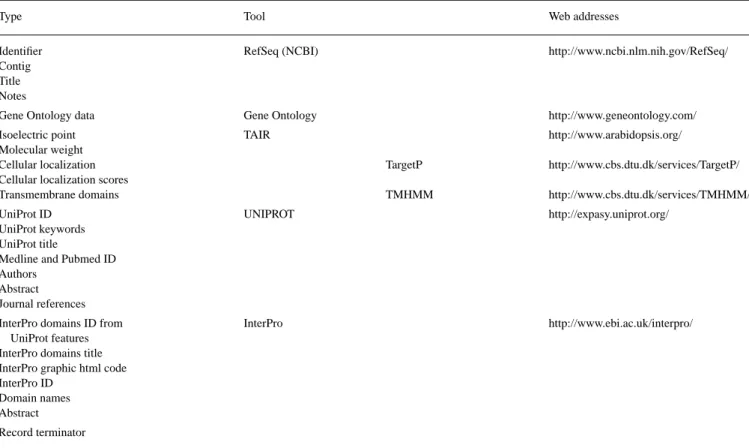BIOINFORMATICS
APPLICATIONS NOTE
Vol. 21 no. 12 2005, pages 2906–2908doi:10.1093/bioinformatics/bti435Genome analysis
Rapid and selective surveillance of Arabidopsis thaliana
genome annotations with Centrifuge
Florence Armand
1, Philipp Bucher
2,3, C. Victor Jongeneel
2,4and Edward E. Farmer
1,∗1Gene Expression Laboratory, Plant Molecular Biology, University of Lausanne, Biology Building, 1015 Lausanne, Switzerland,2Swiss Institute of Bioinformatics, 1015 Lausanne, Switzerland,3ISREC, 1066 Epalinges, Switzerland and4Office of Information Technology, Ludwig Institute for Cancer Research, 1015 Lausanne, Switzerland Received on December 3, 2004; revised on March 22, 2005; accepted on April 5, 2005
Advance Access publication April 7, 2005
ABSTRACT
Summary: Centrifuge is a user-friendly system to simultaneously
access Arabidopsis gene annotations and intra- and inter-organism sequence comparison data. The tool allows rapid retrieval of user-selected data for each annotated Arabidopsis gene providing, in any combination, data on the following features: predicted protein properties such as mass, pI, cellular location and transmembrane domains; SWISS-PROT annotations; Interpro domains; Gene Onto-logy records; verified transcription; BLAST matches to the proteomes of A.thaliana, Oryza sativa (rice), Caenorhabditis elegans, Drosophila
melanogaster and Homo sapiens. The tool lends itself particularly
well to the rapid analysis of contigs or of tens or hundreds of genes identified by high-throughput gene expression experiments. In these cases, a summary table of principal predicted protein features for all genes is given followed by more detailed reports for each individual gene. Centrifuge can also be used for single gene analysis or in a word search mode.
Availability: http://centrifuge.unil.ch/ Contact: edward.farmer@unil.ch
INTRODUCTION
Genomic sequencing of the key model plant Arabidopsis thaliana yielded results of particularly high quality (Arabidopsis Genome Ini-tiative, 2000). Gene structure predictions as well as most functional annotations and many related datasets were provided by The Insti-tute for Genomic Research (http://www.tigr.org) and can be accessed at The Arabidopsis Information Resource (TAIR, Rhee et al., 2003; http://www.arabidopsis.org/) and the Munich Information Center for Protein Sequences (MIPS) Arabidopsis thaliana database (MAtDB; http://mips.gsf.de/proj/thal/db/). In addition to providing genome-derived data and powerful tools for data analysis, TAIR, the largest community resource, also offers links to genetic resources such as ecotype collections and pools of knock-out mutants, etc. A current problem is that, despite the fact that annotations of the A.thaliana sequence are frequently updated, annotations for many genes, par-ticularly those unique to plants, are still of poor quality (Gutiérrez et al., 2004) and will evolve greatly in the future. Centrifuge is com-plementary to current tools for the scrutiny of genome annotation at TAIR but has the advantage of having a single entry page that can accommodate tailored requests for data. This simple tool is highly ∗To whom correspondence should be addressed.
flexible, allowing the analysis of individual genes, lists of genes from gene expression studies or genomic regions. The fast ana-lysis of gene lists from microarray studies is greatly facilitated with Centrifuge.
SYSTEM OVERVIEW
Centrifuge is the web interface of a pre-assembled Arabidopsis database which is automatically compiled from the sources listed in Table 1. The database is compiled as follows: firstly, general annotations for each gene are retrieved from the Reference Sequence (RefSeq) collection from NCBI. TAIR, which employs algorithms to calculate isoelectric point (pI) and mass as well as TargetP, for the pre-diction of cellular location, and TMHMM (transmembrane hidden Markov model) to predict transmembrane domains was also mined for these features (Table 1). We also use subsets of the annotations in UNIPROT (protein functional characteristics and related liter-ature) and InterPro (protein domains with annotations). Gene Onto-logy Consortium information was incorportated into the database. In addition, for every Arabidopsis gene, we performed and incorpor-ted BlastP sequence comparisons (Altschul et al., 1990) with and without a low-complexity region filter (SEG: segment sequence(s) by local complexity) against the following organisms: Arabidop-sis itself, as well as Oryza sativa, Homo sapiens, Caenorhabditis elegans and Drosophila melanogaster. A maximum of 20 BlastP res-ults per inter-organism comparison was retained with a default value of 5 to capture essential information. Lastly, information on whole genome-level transcription (Yamada et al., 2003) was included.
The datasets referenced in Table 1 are retrieved by FTP (File Transfer Protocol) on a server of the SIB (Swiss Institute of Bioin-formatics). We wrote customized Perl scripts to automatically extract and assemble information relevant to Arabidopsis from this source into five files corresponding to the five Arabidopsis chromosomes. These files are indexed for rapid data retrieval. The resulting data-base that underlies Centrifuge is formatted in a SWISS-PROT-like format where each line is flagged with a four or five-letter code and each record begins with the AGI code and ends with a ‘----’ terminator. Our Arabidopsis database itself (compiled as shown in Table 1) is updated a minimum of three times per year to keep pace with improved annotation at each of the different component resources (UNIPROT, InterPro, etc.). A second series of customized Perl scripts were used to allow a rapid search of gene annotations and predicted protein characteristics from the database. The user
Rapid scrutiny of Arabidopsis gene annotations
Table 1. Web resources used to compile the Arabidopsis database underlying Centrifuge
Type Tool Web addresses
Identifier RefSeq (NCBI) http://www.ncbi.nlm.nih.gov/RefSeq/
Contig Title Notes
Gene Ontology data Gene Ontology http://www.geneontology.com/
Isoelectric point TAIR http://www.arabidopsis.org/
Molecular weight
Cellular localization TargetP http://www.cbs.dtu.dk/services/TargetP/
Cellular localization scores
Transmembrane domains TMHMM http://www.cbs.dtu.dk/services/TMHMM/
UniProt ID UNIPROT http://expasy.uniprot.org/
UniProt keywords UniProt title
Medline and Pubmed ID Authors
Abstract Journal references
InterPro domains ID from InterPro http://www.ebi.ac.uk/interpro/
UniProt features InterPro domains title InterPro graphic html code InterPro ID
Domain names Abstract Record terminator
can retrieve all or part of this information for single genes, list of genes or contigs. These Perl scripts take into account the user’s choices to parse the database via the index and display the output information on one page, either in an html format or in a tab-delimited text file. Simple word searches are an additional feature of the tool. Again, Perl was chosen as a query language for its text-processing capabilities. This allows the retrieval of selected words from all fields of individual gene records in Centrifuge. This feature has a low selectivity that we consider advantageous. For example if the word ‘lipoxygenase’ is employed, annotations containing ‘lipoxygenase-like’ or ‘lipoxygenase-binding’ will be recovered. On the output page, and for each individual gene, direct links to Massively Parallel Signature Sequencing (MPSS, http://mpss. udel.edu/at/) and Arabidopsis thaliana Genome Expression (AtGE, http://blast1.salk.edu/cgi-bin/AtGE) and the Nottingham Arabidop-sis Stock Centre Arrays (NASCArrays) resource (http://affymetrix. arabidopsis.info/narrays/experimentbrowse.pl) web pages can be found. This allows easy access to several useful and growing current resources describing gene expression in Arabidopsis.
FUNCTIONALITY AND EXAMPLES OF USE
AGI (Arabidopsis Genome Initiative, 2000) codes (e.g. At3g45140), as well as Affymetrix (http://www.affymetrix.com/) and CATMA (Crowe et al., 2003, http://www.catma.org/) identifiers are accepted for input. Single genes or lists of genes from tab-delimited text files can be entered. Figure 1A shows the homepage into which we have added the single gene At1g55020 that encodes a lipoxygenase. On
the input (home) page we selected several display options. The upper part of the output page for this example is shown in Figure 1B. In this example orthologs for the Arabidopsis gene chosen are found in humans. The protein’s predicted domain structure is given, together with annotations for each individual domain. Being able to simul-taneously display Uniprot features, Interpro domain descriptions and BlastP results against different organisms is unique and is a useful feature of the tool.
Using the word search capacity of Centrifuge with, for example, the terms ‘endosperm’, ‘anther’ or ‘xylem’ yields lists of gene products amongst which useful tissue-specific markers could be iden-tified. ‘Anther’ currently gives 54 hits. The preponderance of genes predicted to encode lipase-like proteins, lipases and lipid transfer proteins indicates an active lipid metabolism and suggests that the tissue might be an attractive hunting ground for new lipid signals.
Centrifuge is most useful for the analysis of genomic regions (con-tigs) as well as gene lists from expression studies, e.g. microarrays. These types of experiments typically identify tens or hundreds of genes which meet the statistical criteria allowing them to be labeled as induced or repressed. Retrieved data are displayed in a summary table indicating the gene identification number, the predicted or known function, the predicted subcellular location, number of predicted transmembrane helices, and the predicted protein domains. Clicking on the column headings sorts gene products sharing the feature in question, e.g. chloroplast location. Clicking on any feature in the table itself brings up the full report for the gene product in question. We analyzed data from Table S2 in Reymond et al. (2004) to reveal that a large proportion (nearly 30%) of insect-inducible genes are
F.Armand et al.
Fig. 1. (A) Homepage for Centrifuge. (B) Output data requested for the LIPOXYGENASE 1 gene.
predicted to encode proteins that enter either the secretory pathway (20%) or the chloroplast compartment (15%). Furthermore, 44% of insect-inducible genes in the same dataset have related sequences in humans.
In summary, the main advantages of Centrifuge are its one page entry format, its rapidity and its flexibility, all of which greatly facil-itate the simultaneous analysis of multiple genes. The scrutiny of long gene lists is accelerated with Centrifuge, allowing a higher throughput exploration of the datastream. With rapidly improving annotations, the tool will become even more powerful in the near future.
ACKNOWLEDGEMENTS
We thank Robin Liechti and Philippe Reymond for helpful dis-cussion. This work was supported by the Swiss National Science Foundation and the University of Lausanne.
REFERENCES
Altschul,S.F. et al. (1990) Basic local alignment search tool. J. Mol. Biol., 215, 403–410.
Arabidopsis Genome Initiative (2000) Analysis of the genome sequence of the flowering plant Arabidopsis thaliana. Nature, 408,
796–815.
Crowe,M.L. et al. (2003) CATMA—A complete Arabidopsis GST database. Nucleic
Acids Res., 31, 156–158.
Gutiérrez,R.A. et al. (2004) Phylogenetic profiling of the Arabidopsis thaliana proteome: what proteins distinguish plants from other organisms? Genome Biol.,
5, R53.
Reymond,P. et al. (2004) A conserved transcript pattern in response to a specialist and a generalist herbivore. Plant Cell, 16, 3132–3147.
Rhee,S.Y. et al. (2003) The Arabidopsis Information Resource (TAIR): a model organism database providing a centralized, curated gateway to Arabidopsis biology, research materials and community. Nucleic Acids Res., 31, 224–228.
Yamada,K. et al. (2003) Empirical analysis of transcriptional activity in the Arabidopsis genome. Science, 302, 842–846.

